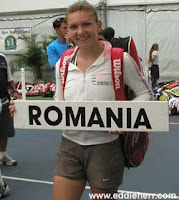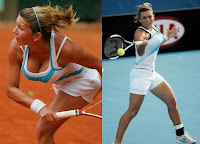Ion Creangă is one of the greatest Romanian writers and storytellers. He was born in the village of Humuleşti, located in the foothills of the Eastern Carpathians, in northern Moldavia, in 1837 he described himself as:
"I am born at March 1 1837 in Humulesti village, Neamt county, from Romanian parents: Stefan of Petrea the shoemaker and his wife Smaranda, born David Creanga, from Pipirig village, Neamt county..."The house in the picture above is the house in which he was born and lived before leaving for school.

This is the wooden cradle in which his mother would watch over him while she span the wool to make some money.

As the eldest child of eight, Creangă's mother wanted him to be educated for Orthodox priesthood, traditionally a prestigious position in the village community.

Details of Creangă's youth can be extracted from his greatest autobiographic work 'Amintiri Din Copilărie' ("Memories of My Boyhood").
He began his education in Humuleşti, then he studied briefly at Broşteni before returning home and enrolling at a school in the neighbouring Târgu Neamţ.
After a year at the seminary in Fălticeni, Creangă left for Iaşi, the Moldavian capital, where he continued to prepare for priesthood at the school of the Socola Monastery.

The house from Humulesti was built by Petrea Ciubotariul, Creangă's grandfather in 1830.
From 1951 it was turned into a museum opened to the public.


Surrounded by vineyards, orchards and forests Cetatuia monastery is located on a hill next to the city of Iasi.
The monastery was built in 1669 by Duca Voda a Moldavian leader.
Used in times of war as a defense rampart the monastery is surrounded with a thick stone wall with loop hole openings, used in medieval times for shooting at approaching enemies.
The church and all the other buildings around served as a hospital for the wounded Romanian soldiers of the World War I.
The monastery was also a shelter of culture having it's own printing house. Dimitrie Cantemir and the metropolit Dosoftei stayed and worked here.

The National Bank of Romania (Romanian: Banca Naţională a României, BNR) is the central bank of Romania and was established in April 1880. It is located in the capital city, Bucharest. The bank's first governor was Eugeniu Carada; the present governor is Mugur Isărescu.
History
In 1916, in the wake of the Central Powers' invasion, the valuables of the National Bank of Romania, together with many other valuables (the Romanian Treasure) were sent to Moscow for safekeeping, but were never returned (except for the Pietroasele treasure - now on display at the National Museum of Romanian History, the numismatic collection of the National Bank, some paintings and archives).
On July 28, 1959, an armed group of six members of the Romanian Communist Party apparatus (the Ioanid Gang: Alexandru Ioanid, Paul Ioanid, Igor Sevianu, Monica Sevianu, Saşa Muşat and Haralambie Obedeanu) stole from an armored car of the National Bank of Romania 1,600,000 lei (about 250,000 U.S. dollars at 1959 prices). It was probably the most scandalous bank robbery in the Eastern bloc.
The Old NBR Palace
The head office of the National Bank of Romania with the view of Lipscani Street is one of the most imposing and massive bank edifices in Romania, nowadays a historic, art monument, and protected as such. It was erected on the former site of the inn built by Şerban Cantacuzino (1678-1688).
On 26 February 1882, architects Cassien Bernard and Albert Galleron were assigned the task to blueprint the NBR Palace. The construction of the building in the eclectic style of the late 19th century, with some neo-classical elements, proceeded between 12 July 1884 (when the foundation stone was laid) and June 1890 under the direction of the architect engineer Nicolae Cerchez assisted by architect E. Băicoianu.
The New NBR Palace
With the façade on Doamnei Street, the new wing of the NBR Palace was built during World War II, after having laid the foundation stone back in 1937.
The construction works carried on between 1942-44 under the direction of architect Ion Davidescu assisted by two other architects, Radu Dudescu and N. Creţoiu.
The building is emblematic of the neo-classical style with rationalist influences that prevailed in the interwar period. It impresses by the monumental granite stairs, the huge Corinthian columns forming the façade, and the large, white marble-coated halls inside the building.
Simona Halep, Romanian Hottie And Future Wimbledon Champion
Current Junior French Open Champion Halep, like Kournikova once was, should soon be competitive enough to make the late rounds of TV tournaments. If she does continue to raise her game, she might be able to parlay her body (of work) into endorsement gold.
For More Pictures of Simona Halep Click Here















 A theme park dedicated to Dracula will be built near the Romanian capital rather than in Transylvania.
A theme park dedicated to Dracula will be built near the Romanian capital rather than in Transylvania.A feasibility study carried out by PriceWaterhouseCoopers claims the park would attract more than a million tourists a year if it were located near the Romanian capital.
They add just 600,000 visitors would come if it was built in the area where the vampire is said to have come from.
Sighisoara was initially chosen because it gave birth to the 15th century prince Vlad the Impaler.
According to legend, the bloodthirsty prince captured invading Turks and common criminals and impaled them on stakes in public market places. That legend inspired Bram Stoker's 1897 novel of the bloodsucking count.
However, residents and officials in Sighisoara are angry at the results of the study, as they had hoped the park would help revive the struggling local economy.
PriceWaterhouseCoopers is to identify the best location for the park near the capital by March, said Tone.
Bucharest also has alleged ties to the prince. Vlad's body is believed to be buried in a monastery he built on an island of Snagov lake, just north of the capital.
Building the park near the capital would also appease conservationists, who have claimed that intensive tourism and construction would damage a medieval citadel in Sighisoara and a protected oak forest.
Romania hopes the park will bring hundreds of thousands of Western tourists.
 The Creation of the World
The Creation of the WorldThe creation of the world in Romanian folklore is most probably based on mazdeist doctrines, which entered the mythologies of many peoples including the Daci, the ancestors of the Romanian people, and which were left behind by these. As such, far from coinciding with the story in the Book of Genesis, cosmogony is largely dualist in nature, depicting the Earth as the common opus of God and the Devil, imagined as counterparts of Ahura Mazda and Angra Mainyu rather than in the biblical way. However, different stories suggest God made the earth with the help of animals, while Satan was trying to thwart his plans.
In the majority of versions, before the earth existed, a boundless ocean called Apa Sâmbetei was the abode of God and the Devil, seen as master and servant rather than equals. Upon deciding to create the earth, God sent the Devil to bring a handful of clay from the ground of the World Ocean in his holy name. The Devil set forth and tried to bring it to the surface in his name instead, but could not succeed until he brought it up in the name of God. As this piece of clay grew into the earth, God laid himself down to sleep. The Devil tried to push him over the side, but the ever expanding earth would hinder that. After trying to throw God off the earth in every one of the four cardinal directions, he shied away from the cross he drew in the ground himself.
The Origin of Evil
Other accounts, closer to the biblical one, suggest that the Devil and his demons were once angels of God. The Devil, however, tried to rebel, and, in response, God opened up the Heavens so that he might fall to the earth. Fearing that Heaven might be voided, the archangel Michael re-sealed it, thus freezing the demons that had not yet fallen to hell in place. This is related to the concept of soul customs, where every soul is intercepted on its way to Heaven by these demons, who force it into hell. It has also given rise to the Romanian saying până ajungi la Dumnezeu, te mănâncă sfinţii (before you reach God, the saints will eat you).
The Origin of God
Another question commonly addressed is that of the origin of God, which is explained in a Russian doll type fashion. Before every God there was another God that created him. Thus explaining the many names the Bible used for God, the Oltenians believed the first God was called Sabaoth, followed by Amon, Apollo, the Creator God of the Bible, and finally, Jesus Christ.
The Origin of Race
Quite surprisingly for a Caucasian race, Romanian folklore asserts that, as God had made the humans out of clay, and clay was perceived to be black like soil, the first humans were black-skinned. It was later during the time of Cain and Abel that God did punish the murderous Cain by bleaching his skin. This is identified as the source of the expression a se îngălbeni de frică (to go yellow with fear), which can also be found in various forms in the folklore of other peoples.
Although, some sources attest that the Dacians were already familiar with dark-skinned people as evidence of the existence of an African race appears to have been found on the territory of Romania:
A new people has been discovered in prehistoric Dacia, this time of ethiopian race and of a blackish-yellow or tan colour. Its stay there has left deep marks in our ethnic, heraldic and geographical nomenclature as to how prehistoric Dacia was first called Ethiopia, then Arabia, and through a longer process, Bessarabia.
– Ionescu, G.M., Etiopienii în Dacia Preistorică / The Ethiopians in Prehistoric Dacia, 1926, Bucharest: Tipografia de Carti LUCIA, p 3.
The Earth
As in other cultures, the Earth was regarded as a giver of life even before Christianity had spread to the Romanian lands, and as such, was personified as the feminine archetype of the Great Mother. This form can be traced back to the Iranian mazdeist religion, where Spenta Armaiti is found as the personification of the Earth. This form endured even after Christian imagery and symbolism became part of Romanian culture, Mother Earth often being identified as the consort of God, the heavenly Father.
The origin of mountains is explained in a number of ways by the cultures of the different regions of Romania. One account is that mountains formed as a response to God demanding the Earth to nurture all life, to which the earth shuddered and brought forth mountains. Another version suggests the Earth was too large to fit under the firmament, and so God attempted to shrink it, thus raising mountains. Often, these accounts are accompanied by the imagery of one or several World Pillars, which sustain the earth from below and are usually placed beneath mountains. Earthquakes are frequently attributed to the earth slipping due to the Devil's constant gnawing at these pillars, which are rebuilt by God and his angels in times of fasting.
The Myth Of The Blajini
As Romanians generally perceived the earth as a disc, they were naturally creative enough to imagine what existed on the other side. This other earth is imagined as a mirror image of our own, and as a home to creatures called Blajini [bla'ʒinʲ] (rom. gentle/kind-hearted ones), sometimes given the name Rohmani ['roh.manʲ] (in Bucovina. They are described as anthropomorphic and short, sometimes having the head of a rat. They are either described as malicious or as having great respect for God and leading a sinless life. They are considered to fast the year through, and thus doing humans a great service.
The Romanian holiday Paştele Blajinilor (the Easter of the Blajini) is a way to repay them for the benefits they bring. Since they live in isolation, they have no way of knowing when Easter comes. It is for this reason that Romanians eat dyed eggs and let the shells flow downstream, from there they believe they will get to the Apa Sâmbetei, and from there to the Blajini.
Some explain them as the descendants of Adam's son Seth. Others state that they used to live alongside humans on the earth, but that Moses, seeing his people oppressed by them, parted the waters and, after he and his people had retreated to safety, poured the waters back onto them, sending them to their current abode.
Adelina is married to Romania and Inter Milan defender Christian Chivu. They were engaged at the end of 2007 and married shortly after Romania’s exit from the Group of death at Euro 2008.
She has her own very successful career as a model and a TV Sports presenter.
I doubt many other countries have such a hottie as a TV Sport presenter, lol.













.
.



Photographs come from the PhotoBlog of Cornel Gingarasu

Happy cows give more milk. This was the belief of five Romanian farmers who are now subject of police investigation after they were found to have been feeding cannabis to their cows.
The farmer aged between 57 and 82, claiming they didn’t know they were doing something illegal by growing the drug in their field, tod the police officers that the drug actually help the cows in producing more milk.
One of the farmers, Ion Astarastoaie said: “We grew it because the cows seemed to like it, and happy cows give more milk.”
Errmmmm......no comment.









